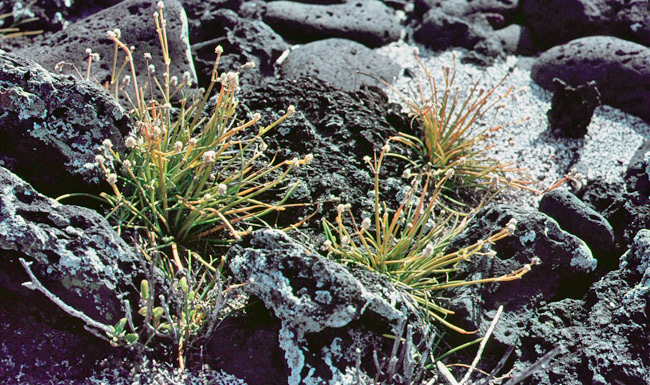
The Amaranthaceae and related families in the
Neotropics and the Pacific
Twenty-three genera of Amaranthaceae occur in the New World and the Hawaiian Islands. Characters of androecium and gynoecium are instrumental in the recognition of genera within the family.
The Amaranthus-type of pollen is found in the majority of
genera of the subfamily Amaranthoideae, but also in several genera of the subfamily Gomphrenoideae as well as in the family Chenopodiaceae. The genus Pseudoplantago with
two known species in Venezuela and Argentina, respectively, has subcuboidal pollen grains. Floral structure as well as other features connect the genus to a group of genera
within the Amaranthoideae. Most genera of the subfamily Gomphrenoideae have pollen of the so-called Gomphrena-type.
Different subfamilies of the Amaranthaceae have differentiated in the Galapagos and Hawaiian Islands. Woodiness has evolved in both archipelagos through the socalled anomalous secondary growth typical of the caryophylliid families. Hybridization and transgression phenomena probably play an important role and may explain the variation patterns in some taxa. Variation within populations sometimes indicates an incipient speciation. In the Galápagos the subfamily Gomphrenoideae is represented by endemic species of Alternanthera, Lithophila and Blutaparon. The single species of Blutaparon is believed to be extinct, probably due to volcanic activity on the island of Santiago between 1897 and 1907, covering the limited distribution area with lava. The extinct species Blutaparon rigidum and the two endemic species of Lithophila appear in pollen structure and other floral morphological structures to be very closely interrelated. The Lithophila species of the island of Santiago deviates in floral details from L. subscaposa and may deserve the recognition as a distinct but hitherto formally undescribed species.
In contrast to its diversification in the Galápagos Islands the subfamily Gomphrenoideae in Hawaii is represented only by introduced weeds. Instead the subfamily Amaranthoideae has speciated, with one genus, Nototrichium, being endemic with two shrubby species. Charpentiera has six endemic species forming trees 6-12 m tall. The three endemic species of Achyranthes are believed to be derived from a single successful colonization event.
Different subfamilies of the Amaranthaceae have differentiated in the Galapagos and Hawaiian Islands. Woodiness has evolved in both archipelagos through the socalled anomalous secondary growth typical of the caryophylliid families. Hybridization and transgression phenomena probably play an important role and may explain the variation patterns in some taxa. Variation within populations sometimes indicates an incipient speciation. In the Galápagos the subfamily Gomphrenoideae is represented by endemic species of Alternanthera, Lithophila and Blutaparon. The single species of Blutaparon is believed to be extinct, probably due to volcanic activity on the island of Santiago between 1897 and 1907, covering the limited distribution area with lava. The extinct species Blutaparon rigidum and the two endemic species of Lithophila appear in pollen structure and other floral morphological structures to be very closely interrelated. The Lithophila species of the island of Santiago deviates in floral details from L. subscaposa and may deserve the recognition as a distinct but hitherto formally undescribed species.
In contrast to its diversification in the Galápagos Islands the subfamily Gomphrenoideae in Hawaii is represented only by introduced weeds. Instead the subfamily Amaranthoideae has speciated, with one genus, Nototrichium, being endemic with two shrubby species. Charpentiera has six endemic species forming trees 6-12 m tall. The three endemic species of Achyranthes are believed to be derived from a single successful colonization event.
Selected publications:
Sánchez-del Pino, I., Vrijdaghs, A., de Block, P., Flores-Olvera, H., Smets, E. & Eliasson, U.: Floral development in Gomphrenoideae (Amaranthaceae) with a focus on androecial tube and appendages. - Botanical Journal of the Linnean Society (London) 190: 315-332 (2019).
Eliasson, U. H.: The evolutionary patterns of the plant family Amaranthaceae on the Galápagos and Hawaiian Islands. - Journal of the Torrey Botanical Society 131: 105-109 (2004).
Eliasson, U.: Portulacaceae. In Smith, N., Mori, S. A., Henderson, A., Stevenson, D. Wm., & Heald, S. V. (eds.), Flowering plants of the Neotropics, pp. 310-312. Princeton, N.J.: Princeton University Press (2004).
Eliasson, U. H.: Molluginaceae, Aizoaceae, Portulacaceae. - In Harling, G. & Andersson, L. (eds.), Flora of Ecuador 55: 1-53 (1996). Published by the Department of Systematic Botany, Göteborg University, and Museum of Natural History, Stockholm.
Eliasson, U. H.: Phytolaccaceae, Achatocarpaceae. - In Harling, G. & Andersson, L. (eds.), Flora of Ecuador 46. 52 pp. (1993). Published by the Department of Systematic Botany, Göteborg University and Museum of Natural History, Stockholm.
Eliasson, U. H.: Species of Amaranthaceae in the Galápagos Islands and their affinities to species on the South American mainland. - In Lawesson, J. E., Hamann, O., Rogers, G., Reck, G. & Ochoa, H. (eds.), Botanical Research and Management in Galápagos. Monographs in Systematic Botany from the Missouri Botanical Garden 32: 29-33 (1990).
Eliasson, U. H.: Floral morphology and taxonomic relations among the genera of Amaranthaceae in the New World and the Hawaiian Islands. - Botanical Journal of the Linnean Society (London) 96: 235-283 (1988).
Eliasson, U. H.: Amaranthaceae. - In Harling, G. & Andersson, L. (eds.), Flora of Ecuador 28. 138 pp. (1987). Published by the Department of Systematic Botany, Göteborg University and Museum of Natural History, Stockholm.
Eliasson, U. H.: Identity and taxonomic affinity of some members of the Amaranthaceae from the Galápagos Islands. - Botanical Journal of the Linnean Society (London) 91: 415-433 (1985). Stockholm.
Eliasson, U.: The families Aizoaceae (pp 182-184), Amaranthaceae (184-207), Basellaceae (208), Batidaceae (208-209), Chenopodiaceae (210-214), Molluginaceae (217-222), Nyctaginaceae (222-228), Phytolaccaceae (229-231), Caryophyllaceae (541-551), Portulacaceae (728-733) in the Galápagos archipelago. - In Wiggins, I. L. & Porter, D. M., Flora of the Galápagos Islands. Stanford University Press, Stanford (1971).
Eliasson, U. H.: The evolutionary patterns of the plant family Amaranthaceae on the Galápagos and Hawaiian Islands. - Journal of the Torrey Botanical Society 131: 105-109 (2004).
Eliasson, U.: Portulacaceae. In Smith, N., Mori, S. A., Henderson, A., Stevenson, D. Wm., & Heald, S. V. (eds.), Flowering plants of the Neotropics, pp. 310-312. Princeton, N.J.: Princeton University Press (2004).
Eliasson, U. H.: Molluginaceae, Aizoaceae, Portulacaceae. - In Harling, G. & Andersson, L. (eds.), Flora of Ecuador 55: 1-53 (1996). Published by the Department of Systematic Botany, Göteborg University, and Museum of Natural History, Stockholm.
Eliasson, U. H.: Phytolaccaceae, Achatocarpaceae. - In Harling, G. & Andersson, L. (eds.), Flora of Ecuador 46. 52 pp. (1993). Published by the Department of Systematic Botany, Göteborg University and Museum of Natural History, Stockholm.
Eliasson, U. H.: Species of Amaranthaceae in the Galápagos Islands and their affinities to species on the South American mainland. - In Lawesson, J. E., Hamann, O., Rogers, G., Reck, G. & Ochoa, H. (eds.), Botanical Research and Management in Galápagos. Monographs in Systematic Botany from the Missouri Botanical Garden 32: 29-33 (1990).
Eliasson, U. H.: Floral morphology and taxonomic relations among the genera of Amaranthaceae in the New World and the Hawaiian Islands. - Botanical Journal of the Linnean Society (London) 96: 235-283 (1988).
Eliasson, U. H.: Amaranthaceae. - In Harling, G. & Andersson, L. (eds.), Flora of Ecuador 28. 138 pp. (1987). Published by the Department of Systematic Botany, Göteborg University and Museum of Natural History, Stockholm.
Eliasson, U. H.: Identity and taxonomic affinity of some members of the Amaranthaceae from the Galápagos Islands. - Botanical Journal of the Linnean Society (London) 91: 415-433 (1985). Stockholm.
Eliasson, U.: The families Aizoaceae (pp 182-184), Amaranthaceae (184-207), Basellaceae (208), Batidaceae (208-209), Chenopodiaceae (210-214), Molluginaceae (217-222), Nyctaginaceae (222-228), Phytolaccaceae (229-231), Caryophyllaceae (541-551), Portulacaceae (728-733) in the Galápagos archipelago. - In Wiggins, I. L. & Porter, D. M., Flora of the Galápagos Islands. Stanford University Press, Stanford (1971).
UNO ELIASSON

University affiliation:
University of Gothenburg
Department of Biological and Environmental Sciences
Email:
uno.botan@gmail.com
Scientific publications:
Click here (pdf) >>